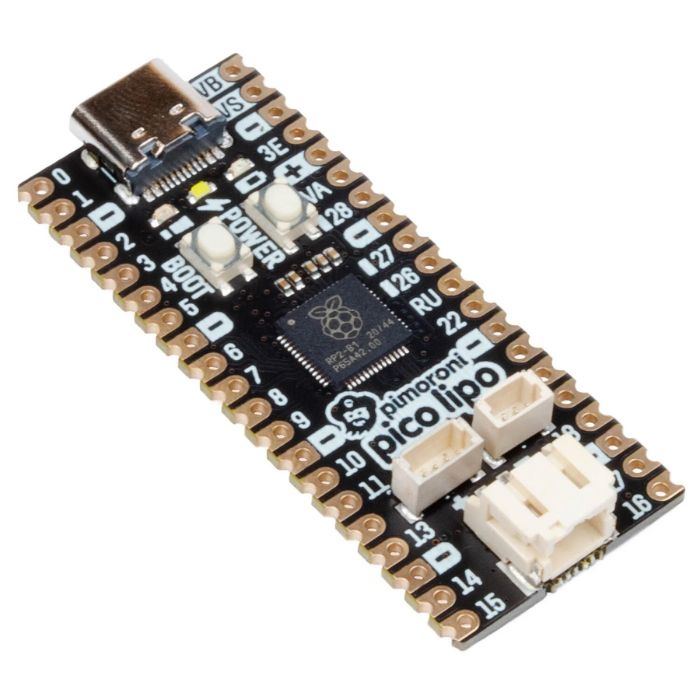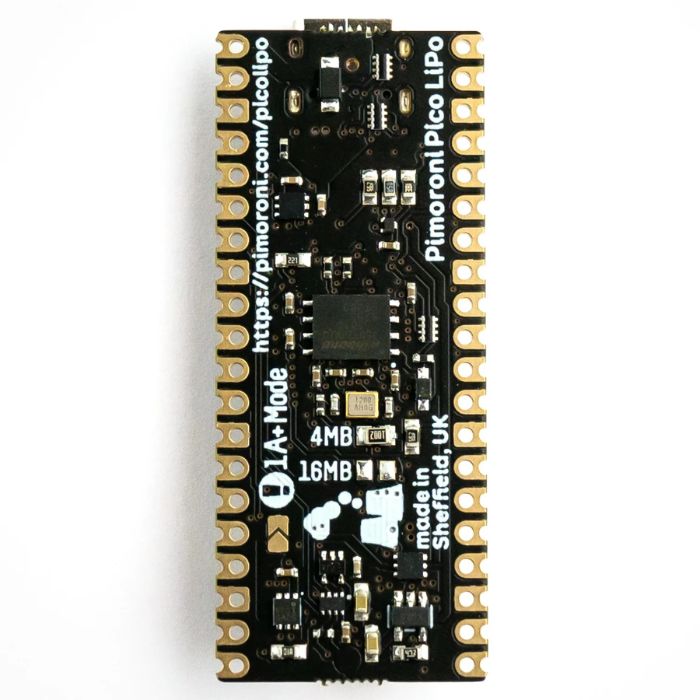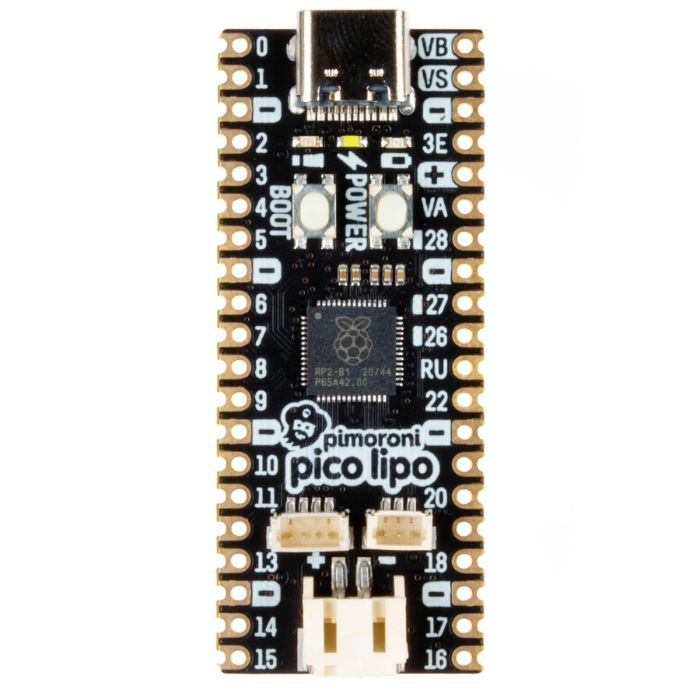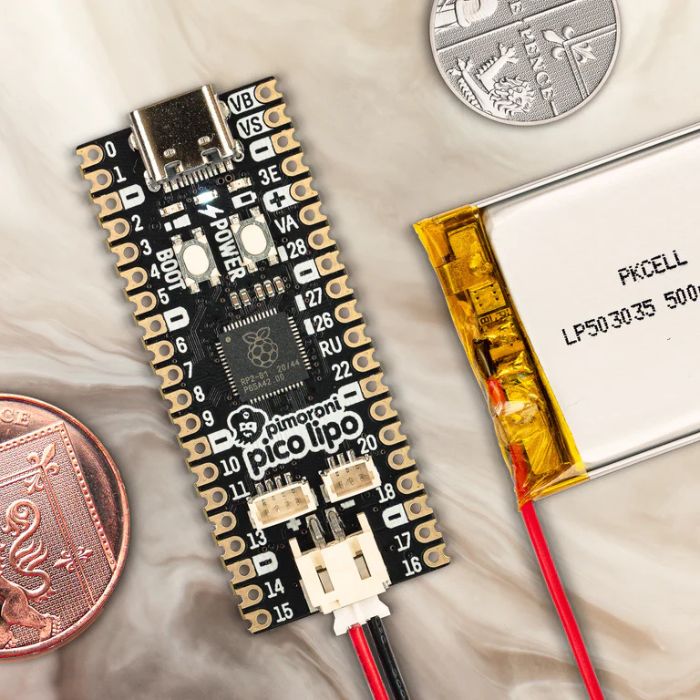Wir lieben die Vielseitigkeit und den Wert des Raspberry Pi Pico, aber seit seiner Veröffentlichung sehnte sich Pimorono uns nach einem aufgemotzten RP2040-Board mit all den Extras, die es gibt. Mit den Pimoroni Pico Boards wurde versucht, so viel zusätzliche Funktionalität wie möglich einzubauen, während die Pico Grundfläche beibehalten worden ist, um die Kompatibilität mit bestehenden Pico Addons zu erhalten.
Das Pimoroni Pico LiPo wird über USB-C mit Strom versorgt und ist programmierbar. Es hat 16 MB QSPI (XiP)-Flash an Bord, um auch die umfangreichsten Projekte zu bewältigen (demnächst wird auch eine 4-MB-Version verfügbar sein). Es gibt einen Qwiic/STEMMA QT-Anschluss, so dass Sie eine ganze Reihe verschiedener Sensoren und Breakouts anschließen können, und einen Debug-Anschluss, falls Sie Ihre Programmierung mit einem SWD-Debugger vornehmen wollen. Da wir im Pirate HQ Knöpfe lieben, gibt es einen Ein/Aus-Knopf und einen BOOTSEL-Knopf, der auch als Benutzerschalter verwendet werden kann.
Der Pimoroni Pico LiPo hat auch ein integriertes LiPo/LiIon-Akku-Management - die eingebaute Ladeschaltung bedeutet, dass das Laden Ihres Akkus so einfach ist wie das Anschließen Ihres Pimoroni Pico Lipo über USB. Es gibt zwei Anzeige-LEDs, die mit dem Akku-Schaltkreis verbunden sind, um Sie über den Ein-/Aus-Status und den Ladestatus zu informieren. Das Gerät ist mit allen unseren LiPo, LiIon und LiPo-Akkus mit hoher Kapazität kompatibel.
Programmierbar mit C++, MicroPython oder CircuitPython, ist Pimoroni Pico LiPo das perfekte Kraftpaket für Ihre tragbaren Projekte.
Sicherheitshinweis! Verwenden Sie Pimoroni Pico LiPo nur mit LiPo- oder LiIon-Akkus und stellen Sie sicher, dass jedes Projekt mit LiPos ausreichend gegen Verbeulen, Verbiegen, Durchstoßen oder Quetschen geschützt ist.
Merkmale
- Stromversorgung durch RP2040
- Dual ARM Cortex M0+ mit bis zu 133Mhz
- 264kB SRAM
- 4MB/16MB QSPI-Flash mit Unterstützung für XiP
- MCP73831-Ladegerät mit 215mA Ladestrom (Datenblatt)
- XB6096I2S Batterieschutz (Datenblatt)
- USB-C-Anschluss für Stromversorgung, Programmierung und Datenübertragung
- 4-poliger Qw-ST-Stecker (Qwiic / STEMMA QT) => Wir haben das Kabel auch bei uns im Sortiment.
- 3-poliger Debug-Stecker (JST-SH)
- 2-poliger JST-PH-Batterieanschluss, mit Polaritätsmarkierung auf der Platine
- Schalter für Basiseingang (dient gleichzeitig als DFU-Auswahl beim Booten)
- Netzschalter
- Betriebs-, Lade- und Benutzer-LED-Anzeigen
- On-board 3V3-Regler (max. Reglerstrom-Ausgang 600mA)
- Eingangsspannungsbereich 3V - 5,5V
- Kompatibel mit Raspberry Pi Pico-Add-ons
- Abmessungen: ca. 53mm x 21mm x 8mm (L x B x H, inklusive Anschlüsse)
Batterien, Kabel und Stiftleisten sind nicht im Lieferumfang enthalten.
Erste Schritte
Pimoroni Pico Boards sind firmware-agnostisch! Sie können sie mit C/C++ oder MicroPython auf die gleiche Weise programmieren wie einen Raspberry Pi Pico. Sie können (viele) weitere Informationen dazu (sowie Download-Links für die Firmware/SDK) auf der RP2040 Landing Page finden.
Sie können auch CircuitPython auf Ihrem Pimoroni Pico LiPo verwenden! CircuitPython ist ein einfach zu benutzendes, gut etabliertes Ökosystem mit vielen Beispielen und Treibern für die Verbindung mit verschiedenen Arten von Hardware. Klicken Sie hier, um die CircuitPython-Firmware für Pimoroni Pico LiPo herunterzuladen und klicken Sie hier, um eine Anleitung für die ersten Schritte zu erhalten.
Hinweise
Der Power-Knopf kann auch als Reset-Knopf verwendet werden, yay! Drücken Sie ihn einfach doppelt, um die Stromzufuhr zu unterbrechen und wiederherzustellen, während Sie den BOOTSEL-Knopf am Pimoroni Pico LiPo gedrückt halten, um in den Bootloader-Modus zu gelangen, ohne dass Kabel ein- und ausgesteckt werden müssen.
English description
We adore the versatility and value of Raspberry Pi Pico but since its release we've been hankering for a souped up RP2040 board with all the extras baked in. With Pimoroni Pico boards, we've tried to cram in as much extra functionality as we possibly can whilst keeping to the Pico footprint to maintain compatibility with existing Pico addons.
Pimoroni Pico LiPo is powered and programmable via USB-C and comes with a mighty 16MB of QSPI (XiP) flash on board to take on the chunkiest of projects (we'll also have a 4MB version available soon). We've made it super easy to connect to things solderlessly too - there's a Qwiic/STEMMA QT connector so you can hook up a whole host of different sensors and breakouts, and a debug connector for if you want to do your programming using a SWD debugger. Because we love buttons at Pirate HQ, there's an on/off button and a BOOTSEL button, which can also be used as a user switch.
Pimoroni Pico LiPo also has onboard LiPo/LiIon battery management - the inbuilt charging circuitry means charging your battery is as easy as plugging your Pimoroni Pico Lipo in via USB. There's two indicator LEDs connected to the battery circuit to keep you informed of on/off state and charging status and it's compatible with any of Pimoroni LiPo, LiIon and high capacity LiPo batteries.
Programmable with C++, MicroPython or CircuitPython, Pimoroni Pico LiPo is the perfect powerhouse for your portable projects.
Safety note! You should only use Pimoroni Pico LiPo with LiPo or LiIon batteries, and you should make sure that any project involving LiPos is sufficiently protected from being dented, bent, punctured or crushed.
Features
- Powered by RP2040
- Dual ARM Cortex M0+ running at up to 133Mhz
- 264kB of SRAM
- 4MB/16MB of QSPI flash supporting XiP
- MCP73831 charger with 215mA charging current (datasheet)
- XB6096I2S battery protector (datasheet)
- USB-C connector for power, programming, and data transfer
- 4 pin Qw-ST (Qwiic / STEMMA QT) connector
- 3 pin debug connector (JST-SH)
- 2-pole JST PH battery connector, with polarity marked on the board
- Switch for basic input (doubles up as DFU select on boot)
- Power button
- Power, charging and user LED indicators
- On-board 3V3 regulator (max regulator current output 600mA)
- Input voltage range 3V - 5.5V
- Compatible with Raspberry Pi Pico add-ons
- Measurements: approx 53mm x 21mm x 8mm (L x W x H, including connectors)
Batteries, cables and headers are not included - check out the extras tab!
Getting Started
Pimoroni Pico boards are firmware agnostic! You can program them with C/C++ or MicroPython in the same way as you would a Raspberry Pi Pico. You can find (lots) more information on how to do that (as well as download links for the firmware/SDK) on the RP2040 landing page.
You can also use CircuitPython on your Pimoroni Pico LiPo! CircuitPython is an easy to use, well-established ecosystem with lots of example code and drivers for interfacing with different kinds of hardware. Click here to download the CircuitPython firmware for Pimoroni Pico LiPo and click here for a getting started guide.
Notes
The power button can also be used as a reset button, yay! Just double press it to cut and reinstate the power whilst holding down the BOOTSEL button on the Pimoroni Pico LiPo to get into bootloader mode, with no plugging and unplugging of cables required.
Sicherheitsangaben
- Lesen Sie die Bedienungsanleitung sorgfältig durch, bevor Sie das Produkt verwenden.
- Stellen Sie sicher, dass alle Montage- und Installationsanweisungen des Herstellers sorgfältig befolgt werden.
- Verwenden Sie das Produkt nur für den vorgesehenen Zweck.
- Die unsachgemäße Nutzung dieses Produkts kann zu schweren Verletzungen oder Sachschäden führen.
- Nicht für Kinder unter 10 Jahren geeignet.
- Bei unsachgemäßer Verwendung besteht eine Verletzungsgefahr.
- Dieses Produkt entspricht den geltenden Sicherheitsanforderungen der Europäischen Union.
- Dieses Produkt wurde gemäß der GPSR geprüft, die sicherstellt, dass alle relevanten Sicherheitsanforderungen für Konsumgüter eingehalten werden.
Nachverfolgbarkeitsinformationen
Jedes Produkt verfügt über eines oder mehrere der folgenden Merkmale:
- Ein CE-Kennzeichen, das die Einhaltung der Sicherheits-, Gesundheits- und Umweltschutzanforderungen der Europäischen Union anzeigt.
- Eine eindeutige Serien- oder Chargennummer, um die Nachverfolgbarkeit zu gewährleisten und bei Bedarf Rückrufaktionen zu unterstützen.
- Hersteller- und Importeurangaben für den Kundensupport und Sicherheitsanfragen.
Überwachung und Berichterstattung von Vorfällen
Für den unwahrscheinlichen Fall eines Produktproblems haben wir Verfahren implementiert, um:
- Kundenbeschwerden zeitnah bearbeiten.
- Schwerwiegende Vorfälle über das EU Safety Gate/RAPEX-System melden.
- Mit den Marktüberwachungsbehörden zusammenarbeiten, um die öffentliche Sicherheit zu gewährleisten.
Kontakt:
- Email: support [@] pi3g.com
- Telefon: 0341 / 392 858 40
Dieses Produkt ist vollständig mit allen geltenden EU-Vorschriften konform, um die Sicherheit unserer geschätzten Kunden zu gewährleisten.





